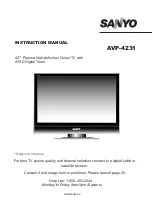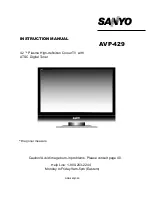
Reference Information
Samsung Electronics
14-5
VESA Plug & Play
This function enables the automatic recognition of devices
when connecting the TV to the computer without additional set-
tings.
S-VIDEO IN Port
This is called super video. S-Video is a type of video signal
which has the video luminance and the color signal separated
in order to provide better visual quality.
VHF/UHF
VHF refers to TV channels 2 to 13, and UHF refers to TV chan-
nels 14 to 69.
Pixels, Resolution
The pixels are the number of small dots that make up the TV screen. The resolution represents the number of pixels on a screen.
For example, if the resolution of a TV is 852x480, it means the width of the screen consists of 852 pixel columns and the height of
the screen consists of 480 pixel rows. In this case, the total number of pixels on the screen is 408,960. The more pixels there are,
the higher the visual quality that can be achieved because the picture on the screen is displayed with more pixels and therefore
with more detail.
Gradation, Color Depth
Gradation describes the number of gradual brightness levels. Since all information is represented by binary numbers in a digital
system, the Gradation is determined by the number of bits used to represent the brightness levels of a pixel on the TV screen. For
example, if a pixel is represented by 8 bits, the Gradation is 28 or 256. Since a TV uses the three primary colors of light, R, G and
B, the number of possible colors for a pixel is 256 x 256 x 256, 16,777,216, or 16.7 million colors. If 12 bits are used for a pixel, the
gradation is 212 or 4096 for a color. Since three colors R, G and B are used, 4096 x 4096 x 4096 or 68.7 billion colors are support-
ed per pixel. Since 68.7 billion colors are far more than 16.7 million colors, the picture will be displayed by far more abundant and
natural colors using a 12 bit pixel. That is, since Gradation means the number of brightness levels, color represented by 4096 lev-
els appears more natural than color represented by 256 levels.
Contrast
The contrast is the ratio of brightness of the brightest color to the darkest color. The contrast is calculated by dividing the bright-
ness of the brightest color by the brightness of the darkest color. For example, if the brightness of the darkest color is 1 and the
brightness of the brightest color is 3000, then the Contrast is 3000/1 or 3000. A higher contrast means that a dark color is dis-
played darker and bright color is displayed brighter so that the screen contrast can be easily distinguished. The contrast differs
from the Gradient which means the number of brightness levels.
Therefore, if someone says that a 5000:1 contrast displays a color by 5000 levels, he is confusing Contrast with Gradation.
Brightness
Brightness is the brightness per unit screen area, the unit for brightness is candela (cd). For example, 1000cd/m2 means the
brightness that is measured when 1000 candles are lit within 1 square meters area.
852
480
42SD = 409K Pixels
Содержание HPS5033X
Страница 11: ...1 6 Samsung Electronics MEMO ...
Страница 47: ...3 30 Samsung Electronics MEMO ...
Страница 50: ...Samsung Electronics 5 2 MEMO ...
Страница 64: ...6 14 Samsung Electronics MEMO ...
Страница 68: ...Block Diagram 7 4 Samsung Electronics 7 2 3 Module Driver Board Block Diagram 1 Y Main Board 2 X Main Board ...
Страница 70: ...7 6 Samsung Electronics MEMO ...
Страница 139: ...Circuit Description 13 18 Samsung Electronics Scan_l Even_Scan Y Sustain ...
Страница 140: ...Circuit Description Samsung Electronics 13 19 Attachment 2 X Output Waveform X Sustain ...
Страница 141: ...13 20 Samsung Electronics MEMO ...


































